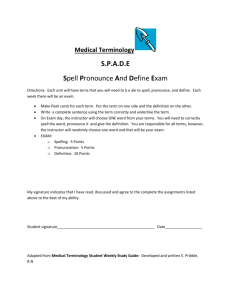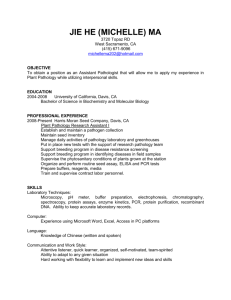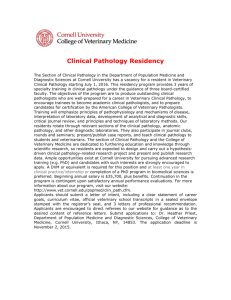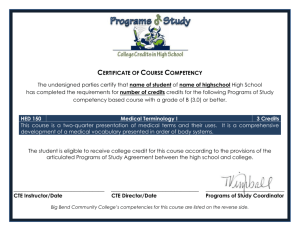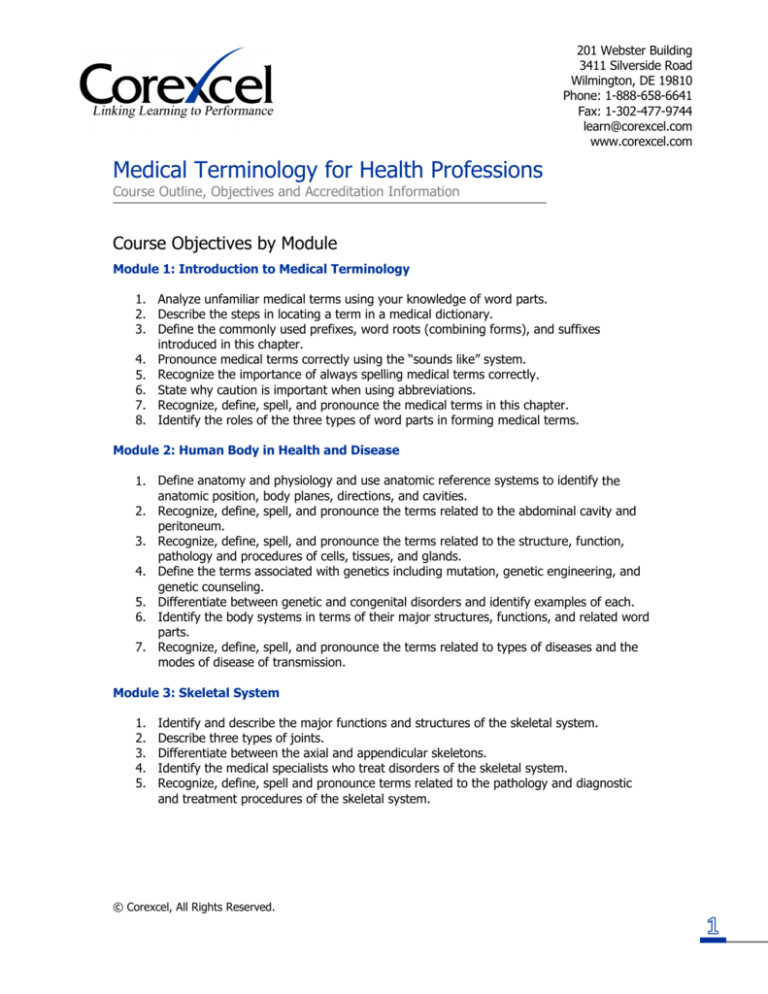
201 Webster Building
3411 Silverside Road
Wilmington, DE 19810
Phone: 1-888-658-6641
Fax: 1-302-477-9744
learn@corexcel.com
www.corexcel.com
Medical Terminology for Health Professions
Course Outline, Objectives and Accreditation Information
Course Objectives by Module
Module 1: Introduction to Medical Terminology
1. Analyze unfamiliar medical terms using your knowledge of word parts.
2. Describe the steps in locating a term in a medical dictionary.
3. Define the commonly used prefixes, word roots (combining forms), and suffixes
introduced in this chapter.
4. Pronounce medical terms correctly using the “sounds like” system.
5. Recognize the importance of always spelling medical terms correctly.
6. State why caution is important when using abbreviations.
7. Recognize, define, spell, and pronounce the medical terms in this chapter.
8. Identify the roles of the three types of word parts in forming medical terms.
Module 2: Human Body in Health and Disease
1. Define anatomy and physiology and use anatomic reference systems to identify the
anatomic position, body planes, directions, and cavities.
2. Recognize, define, spell, and pronounce the terms related to the abdominal cavity and
peritoneum.
3. Recognize, define, spell, and pronounce the terms related to the structure, function,
pathology and procedures of cells, tissues, and glands.
4. Define the terms associated with genetics including mutation, genetic engineering, and
genetic counseling.
5. Differentiate between genetic and congenital disorders and identify examples of each.
6. Identify the body systems in terms of their major structures, functions, and related word
parts.
7. Recognize, define, spell, and pronounce the terms related to types of diseases and the
modes of disease of transmission.
Module 3: Skeletal System
1.
2.
3.
4.
5.
Identify and describe the major functions and structures of the skeletal system.
Describe three types of joints.
Differentiate between the axial and appendicular skeletons.
Identify the medical specialists who treat disorders of the skeletal system.
Recognize, define, spell and pronounce terms related to the pathology and diagnostic
and treatment procedures of the skeletal system.
© Corexcel, All Rights Reserved.
Course Outline, Objectives & Accreditation Information
Medical Terminology for Health Professions
Module 4: Muscular System
1. Describe the functions and structures of the muscular system including muscle fibers,
fascia, tendons, and the three types of muscles.
2. Recognize, define, spell, and pronounce the terms related to muscle movements and
how muscles are named.
3. Recognize, define, pronounce, and spell the terms related to the pathology and
diagnostic and treatment procedures of the muscular system.
Module 5: Cardiovascular System
1. Describe the heart in terms of chambers, valves, blood flow, heartbeat, blood supply,
and heart sounds.
2. Differentiate among the three different types of blood vessels and describe the major
function of each.
3. Identify the major components of blood and the major functions of each.
4. State the difference between pulmonary and systemic circulation.
5. Recognize, define, spell, and pronounce the terms related to the pathology, diagnostic
and treatment procedures of the cardiovascular system.
Module 6: Lymphatic and Immune System
1. Describe the major functions and structures of the lymphatic and immune systems.
2. Recognize, define, spell, and pronounce the major terms related to pathology and
diagnostic and treatment procedures of the lymphatic and immune systems.
3. Recognize, define, spell, and pronounce terms related to oncology.
Module 7: Respiratory System
1. Identify and describe the major structures and functions of the respiratory system.
2. Recognize, define, spell, and pronounce terms related to the pathology and diagnostic
and treatment procedures of the respiratory system.
Module 8: Digestive System
1. Identify and describe the major structures and functions of the digestive system.
2. Describe the processes of digestion, absorption, and metabolism.
3. Recognize, define, spell, and pronounce terms related to the pathology and diagnostic
and treatment procedures of the digestive system.
Module 9: Urinary System
1. Describe the major functions of the urinary system.
2. Name and describe the structures of the urinary system.
3. Recognize, define, spell, and pronounce terms related to the pathology and diagnostic
and treatment procedures of the urinary system.
© Corexcel, All Rights Reserved.
Course Outline, Objectives & Accreditation Information
Medical Terminology for Health Professions
Module 10: Nervous System
1. Describe the functions and structures of the nervous system.
2. Identify the major divisions of the nervous system and describe the structures of each by
location and function.
3. Identify the medical specialists who treat disorders of the nervous system.
4. Recognize, define, spell, and pronounce terms related to the pathology and diagnostic
and treatment procedures of the nervous system.
5. Recognize, define, spell, and pronounce terms related to the pathology and diagnostic
and treatment procedures of mental health disorders.
Module 11: Special Senses - The Eyes & Ears
1. Describe the functions and structures of the eyes and adnexa.
2. Recognize, define, spell, and pronounce terms related to the pathology and diagnostic
and treatment procedures of eye disorders.
3. Describe the functions and structures of the ears.
4. Recognize, define, spell, and pronounce terms related to the pathology and diagnostic
and treatment procedures of ear disorders.
Module 12: Skin - The Integumentary System
1. Identify and describe the functions and structures of the integumentary system.
2. Identify the medical specialists associated with the integumentary system.
3. Recognize, define, spell, and pronounce the terms used to describe the pathology and
diagnostic and treatment procedures related to the skin.
4. Recognize, define, spell, and pronounce terms used to describe the pathology and
diagnostic and treatment procedures related to hair, nails, and sebaceous glands.
Module 13: Endocrine System
1. Describe the role of the hypothalamus and endocrine glands in maintaining homeostasis.
2. Name and describe the functions of the primary hormones secreted by each of the
endocrine glands.
3. Recognize, define, spell, and pronounce terms relating to the pathology and diagnostic
and treatment procedures of the endocrine glands.
Module 14: Reproductive System
1. Identify and describe the major functions and structures of the male reproductive
system.
2. Recognize, define, spell, and pronounce the terms related to the pathology and
diagnostic and treatment procedures of the male reproductive system.
4. Identify and describe the major functions and structures of the female reproductive
system.
5. Recognize, define, spell, and pronounce the terms related to the pathology and
diagnostic and treatment procedures of the female reproductive system.
6. Recognize, define, spell, and pronounce the terms related to the pathology and
diagnostic and treatment procedures of the female during pregnancy, childbirth, and the
postpartum period.
© Corexcel, All Rights Reserved.
Course Outline, Objectives & Accreditation Information
Medical Terminology for Health Professions
Module 15: Diagnostic Procedures and Pharmacology
1. Describe the four vital signs recorded for most patients.
2. Recognize, define, spell, and pronounce the terms associated with basic examination
procedures.
3. Identify and describe the basic examination positions.
4. Recognize, define, spell, and pronounce terms associated with frequently performed
blood and urinalysis laboratory tests.
5. Recognize, define, spell, and pronounce terms associated with radiography and other
imaging techniques.
6. Differentiate between projection and position and describe basic radiographic projections.
7. Recognize, define, spell, and pronounce the pharmacology terms introduced in this
chapter.
Course Outline
I.
Module 1 - Introduction to Medical Terminology
a. Word Parts
i. Overview
ii. The three types of word parts
b. Word Roots (Combining Forms)
i. Combining Vowels
ii. Commonly Used Word Roots (Combining Forms)
c. Suffixes
i. Suffixes Meaning “Pertaining To”
ii. Suffixes as Noun Endings
iii. Suffixes Meaning “Abnormal Conditions
iv. Suffixes Related to Pathology
v. Suffixes Related to Procedures
vi. The Double RRs
d. Prefixes
i. Contrasting & Confusing Prefixes
e. Determining Meanings Based on Word Parts
f. Taking Terms Apart
i. As an Example
g. Medical Dictionary Use
i. Guessing at Meanings
ii. If You Know How to Spell the Word
iii. If You Don’t Know How to Spell the Word
iv. Look Under Categories
h. Pronunciation
i. Spelling
j. Using Abbreviations
k. Singular & Plural Endings
l. Basic Medical Terms
m. Look-Alike Sound-Alike Terms & Word Parts
© Corexcel, All Rights Reserved.
Course Outline, Objectives & Accreditation Information
Medical Terminology for Health Professions
II.
Module 2 - Human Body in Health and Disease
a. Anatomic Reference Systems
i. Anatomy & Physiology Defined
ii. Body Planes
iii. Body Directions
b. Major Body Cavities
i. Dorsal Cavity
ii. Ventral Cavity
iii. Divisions of the Abdomen
iv. Regions of the Thorax and Abdomen
v. Peritoneum
vi. Laparoscopic Procedures
c. Cytology
i. Chromosomes
ii. DNA
iii. Terms Related to Genetics
iv. Genetic Disorders
v. Genetic Counseling
d. Congenital Disorders
e. Histology
i. Stem Cells
ii. Types of Tissue
iii. Pathology of Tissue Formation
f. Glands
i. Pathology and Procedures of Glands
g. Organs and Body Systems
h. Pathology
i. Disease Transmission
ii. Outbreaks of Diseases
III.
Module 3 - Skeletal System
a.
b.
c.
d.
e.
Functions of the Skeletal System
Structures of the Skeletal System
Structure of Bones
Joints
Skeleton
i. Axial Skeleton
ii. Appendicular Skeleton
iii. Bones of the Skull
iv. Thoracic Cavity, Ribs & Sternum
v. Shoulders, Arms, Wrists & Hands
vi. Spinal Column
vii. Pelvic Girdle
viii. Legs, Knees, Ankles & Feet
f. Medical Specialties Related to the Skeletal System
g. Pathology of the Skeletal System
i. Joints
ii. Arthritis
iii. Spinal Column
iv. Bone
h. Diagnostic Procedures of the Skeletal System
© Corexcel, All Rights Reserved.
Course Outline, Objectives & Accreditation Information
Medical Terminology for Health Professions
i.
Treatment Procedures of the Skeletal System
i. Medications
ii. Bone Marrow Transplants
j. Joints
k. Joint Replacement
l. Spinal Column
m. Bones
i. Treatment of Fractures
ii. External & Internal Fixation
IV.
Module 4 - Muscular System
a. Functions of the Muscular System
b. Structures of the Muscular System
i. Muscle Fibers
ii. Fascia & Tendons
iii. Aponeurosis
c. Types of Muscle Tissue
i. Skeletal Muscles
ii. Smooth Muscles
iii. Cardiac Muscle
d. Characteristics of Muscles
i. Antagonistic Muscle Pairs
ii. Contraction and Relaxation
iii. Muscle Innervation
e. Range of Motion
i. Abduction & Adduction
ii. Flexion & Extension
iii. Elevation & Depression
iv. Rotation & Circumduction
v. Supination & Pronation
vi. Dorsiflexion & Plantar Flexion
f. How Muscles are Named
i. Origin & Insertion
ii. Muscles Named for Their Action
iii. Muscles Named for Their Location
iv. Muscles Named for Fiber Direction
v. Muscles Named for Their Size
vi. Muscles Named for Their Shape
g. Medical Specialties Related to the Muscular System
i. Skeletal Muscle Disorders
ii. Smooth Muscle Disorders
iii. Cardiac Muscle Disorders
h. Pathology of the Muscular System
i. Fibers, Fascia & Tendons
ii. Muscles
iii. Repetitive Stress Disorders
iv. Sports Injuries
v. Paralysis
i. Diagnostic Procedures of the Muscular System
© Corexcel, All Rights Reserved.
Course Outline, Objectives & Accreditation Information
Medical Terminology for Health Professions
j.
V.
Treatment Procedures of the Muscular System
i. Medications
ii. Physical Therapy
iii. Fascia
iv. Tendons
v. Muscles
Module 5 - Cardiovascular System
a. Functions of the Cardiovascular System
b. Structures of the Cardiovascular System
c. The Heart
i. The Pericardium
ii. The Walls of the Heart
iii. The Blood Supply to the Myocardium
iv. The Heart Chambers
v. The Heart Valves
vi. Systemic and Pulmonary Circulation
vii. The Heartbeat
viii. Heart Sounds
d. Blood Vessels
i. Arteries
ii. Capillaries
iii. Veins
iv. Pulse & Blood Pressure
e. The Blood
i. Plasma
ii. Erythrocytes
iii. Leukocytes
iv. Thrombocytes
v. Blood Types
vi. The Rh Factor
vii. Blood Gases
f. Medical Specialties Related to the Cardiovascular System
g. Pathology of the Cardiovascular System
i. Coronary Artery Disease
ii. Congestive Heart Failure
iii. Forms of Carditis
iv. Heart Valves
v. Arrhythmias
vi. Fibrillation
vii. Blood Vessels
viii. Arteries
ix. Veins
x. Thrombosis & Embolisms
xi. Blood Disorders
xii. Blood Cells
xiii. Anemias
xiv. Hypertension
h. Diagnostic Procedures of the Cardiovascular System
i. Electrocardiography
ii. Ultrasonic Diagnostic Procedures
© Corexcel, All Rights Reserved.
Course Outline, Objectives & Accreditation Information
Medical Terminology for Health Professions
i.
VI.
Treatment Procedures of the Cardiovascular System
i. Antihypertensive Medication
ii. Additional Medications
iii. Cleaning Blocked Arteries
iv. Coronary Artery Bypass Graft
v. Heart
vi. Blood Vessels, Blood & Bleeding
Module 6 - Lymphatic & Immune System
a. Medical Specialties Related to the Lymphatic and Immune Systems
b. Functions and Structures of the Lymphatic System
i. Functions of the Lymphatic System
ii. Structures of the Lymphatic System
c. Pathology and Diagnostic Procedures of Lymphatic Structures
d. Functions and Structures of the Immune System
i. Functions of the Immune System
ii. Structures of the Immune System
iii. The First Lines of Defense
iv. The Immune Response
v. Specialized Cells of the Immune Reactions
vi. Immunity
vii. Immune System Response Factors
e. Pathology and Diagnostic Procedures of the Immune System
i. Allergic Reactions
ii. Autoimmune Disorders
iii. Immunodeficiency
f. Treatment Procedures of the Immune System
i. Immunotherapy
ii. Antibody Therapy
iii. Immunosuppression
g. Pathogenic Organisms
i. Bacteria
ii. Fungus, Yeast & Parasites
iii. Viruses
iv. Medications to Control Infections
h. Oncology
i. Terms Related to Tumors
ii. Staging
iii. Carcinomas
iv. Sarcomas
v. Lymphomas
vi. Blastomas
vii. Breast Cancer
viii. Cancer Treatments
VII.
Module 7 - Respiratory System
a. Functions of the Respiratory System
b. Structures of the Respiratory System
i. Nose
ii. Tonsils
iii. Sinuses
iv. Pharynx
© Corexcel, All Rights Reserved.
Course Outline, Objectives & Accreditation Information
Medical Terminology for Health Professions
v. Larynx
vi. Trachea
vii. Bronchial Tree
viii. Alveoli
ix. Lungs
x. Mediastinum
xi. Pleura
xii. Diaphragm
c. Respiration
i. External Respiration
ii. Internal Respiration
d. Medical Specialties Related to the Respiratory System
e. Pathology of the Respiratory System
i. Chronic Obstructive Pulmonary Diseases
ii. Upper Respiratory Diseases
iii. Pharynx & Larynx
iv. Trachea & Bronchi
v. Pleural Cavity
vi. Lungs
vii. Breathing Disorders
viii. Lack of Oxygen
ix. Sudden Infant Death Syndrome
f. Diagnostic Procedures of the Respiratory System
g. Treatment Procedures of the Respiratory System
i. Medications
ii. Nose & Throat
iii. Trachea & Bronchi
iv. Lungs, Pleura & Thorax
v. Respiratory Therapy
VIII.
Module 8 - Digestive System
a. Functions of the Digestive System
b. Structure of the Digestive System
i. Gastrointestinal Tract
ii. Oral Cavity
iii. Pharynx
iv. Esophagus
v. Stomach
vi. Small Intestine
vii. Large Intestine
viii. Accessory Digestive Organs
c. Digestion
i. Metabolism
ii. Absorption
iii. Role of the Mouth, Salivary Glands & Esophagus
iv. Role of the Stomach
v. Role of the Small Intestine
vi. Role of the Large Intestine
d. Medical Specialties Related to the Digestive System
e. Pathology of the Digestive System
i. Tissues of the Oral Cavity
ii. Dental Diseases
iii. Esophagus
© Corexcel, All Rights Reserved.
Course Outline, Objectives & Accreditation Information
Medical Terminology for Health Professions
iv. Stomach
v. Eating Disorders
vi. Digestion & Vomiting
vii. Intestinal Disorders
viii. Anorectal Disorders
ix. Liver
x. Gallbladder
f. Diagnostic Procedures of the Digestive System
i. Endoscopic Procedures
g. Treatment Procedures of the Digestive System
i. Medications
ii. Oral Cavity & Esophagus
iii. Stomach
iv. Intestines
v. Liver
vi. Gallbladder
IX.
Module 9 - Urinary System
a. Functions of the Urinary System
b. Structures of the Urinary System
i. Kidneys
ii. Ureters
iii. Urinary Bladder
iv. Urethra
c. Excretion of Urine
d. Medical Specialties Related to the Urinary System
e. Pathology of the Urinary System
i. Renal Failure
ii. Nephrotic Syndrome
iii. Kidneys
iv. Stones
v. Ureters
vi. Urinary Bladder
vii. Urethra
viii. Urination
f. Diagnostic Procedures of the Urinary System
g. Treatment Procedures of the Urinary System
i. Medications
ii. Dialysis
iii. Kidneys
iv. Ureters
v. Urinary Bladder
vi. Urethra
X.
Module 10 - Nervous System
a. Functions of the Nervous System
b. Structures of the Nervous System
i. Nerves
ii. Reflexes
iii. Neurons
iv. Synapses
v. Neurotransmitters
© Corexcel, All Rights Reserved.
Course Outline, Objectives & Accreditation Information
Medical Terminology for Health Professions
c.
d.
e.
f.
g.
h.
i.
j.
XI.
vi. Neuroglia
vii. Myelin Sheath
Central Nervous System
i. Meninges
ii. Cerebrospinal Fluid
iii. Cerebrum
iv. Thalamus
v. Cerebellum
vi. Brainstem
vii. Spinal Cord
Peripheral Nervous System
i. Cranial Nerves
ii. Spinal Nerves
Autonomic Nervous System
Medical Specialties Related to the Nervous System
Pathology of the Nervous System
i. Head & Meninges
ii. Disorders of the Brain
iii. Brain Injuries
iv. Altered States of Consciousness
v. Brain Tumors
vi. Strokes
vii. Sleep Disorders
viii. Spinal Cord
ix. Nerves
x. Abnormal Sensations
xi. Cerebral Palsy
xii. Convulsions & Seizures
xiii. Epilepsy
Mental Health
i. Developmental Disorders
ii. Substance-Related Disorders
iii. Schizophrenia & Other Psychotic Disorders
iv. Mood Disorders
v. Panic Disorders
vi. Anxiety Disorders
vii. Phobias
viii. Somatoform Disorders
ix. Impulse Control Disorders
x. Personality Disorder
Diagnostic Procedures of the Nervous System
Treatment Procedures of the Nervous
i. Medications to Treat Mental Disorders
ii. Pain Control
iii. Sedative & Hypnotic Medications
iv. Anesthesia
v. Brain & Head
vi. Nerves
Module 11 - Special Senses: Eyes & Ears
a. Medical Specialties Related to the Eyes and Ears
b. Functions of the Eyes and Ears
© Corexcel, All Rights Reserved.
Course Outline, Objectives & Accreditation Information
Medical Terminology for Health Professions
c.
d.
e.
f.
g.
h.
i.
j.
k.
XII.
Structures of the Eyes
i. Adnexa of the Eyes
ii. Eyeball
iii. Sclera
iv. Uveal Tract
v. Retina
vi. Segments of the Eyes
vii. Normal Action of the Eyes
Pathology of the Eyes
i. Eyelids
ii. Additional Adnexa Pathology
iii. Sclera, Cornea & Iris
iv. Eye
v. Functional Defects
vi. Refractive Disorders
vii. Blindness
Diagnostic Procedures of the Eyes
i. Routine Diagnostic Procedures
ii. Specialized Diagnostic Procedures
Treatment Procedures of the Eyes
i. Orbit & Eyelids
ii. Conjunctiva, Cornea & Iris
iii. Cataract Surgery
iv. Laser Treatments
Structures of the Ears
i. Outer Ear
ii. Middle Ear
iii. Inner Ear
Normal Action of the Ears
Pathology of the Ears
i. Outer Ear
ii. Middle Ear
iii. Inner Ear
iv. Hearing Loss
Diagnostic Procedures of the Ears
Treatment Procedures of the Ears
i. Outer Ear
ii. Middle Ear
Module 12 - Skin: The Integumentary System
a. Functions of the Integumentary System
i. Functions of the Skin
ii. Functions of Related Structures
b. Structures of the Integumentary System
i. Skin
ii. Epidermis
iii. Dermis
iv. Subcutaneous Layer
c. Associated Structures of the Integumentary System
i. Sebaceous Glands
ii. Sweat Glands
iii. Hair
iv. Nails
© Corexcel, All Rights Reserved.
Course Outline, Objectives & Accreditation Information
Medical Terminology for Health Professions
d. Medical Specialties Related to the Integumentary System
e. Pathology of the Integumentary System
i. Sebaceous Gland Disorders
ii. Sweat Glands Disorders
iii. Hair
iv. Nails
v. Pigmentation
vi. Surface Lesions
vii. Fluid-Filled Lesions
viii. Lesions Through the Skin
ix. Birthmarks
x. General Skin Conditions
xi. Bacterial Skin Infections
xii. Fungal Skin Infections
xiii. Parasitic Skin Infestations
xiv. Skin Growths
xv. Skin Cancer
xvi. Burns
f. Diagnostic Procedures of the Integumentary System
g. Treatment Procedures of the Integumentary System
i. Transdermal Medications
ii. Preventive Measures
iii. Tissue Removal
iv. Laser Treatment of Skin Conditions
v. Cosmetic Procedures
XIII.
Module 13 - Endocrine System
a. Functions of the Endocrine System
i. Steroid Hormones
ii. Anabolic Steroids
b. Structures of the Endocrine System
c. Medical Specialties Related to the Endocrine System
d. Pathology of the Endocrine System
e. Diagnostic Procedures Related to the Endocrine System
f. Pituitary Gland
i. Functions
ii. Secretions: Anterior Lobe
iii. Secretions: Posterior Lobe
iv. Pathology
v. Treatment Procedures
g. Thyroid Gland
i. Functions
ii. Secretion
iii. Pathology
iv. Diagnostic & Treatment Procedures
h. Parathyroid Glands
i. Functions
ii. Secretions
iii. Pathology
iv. Treatment Procedure: Parathyroid
© Corexcel, All Rights Reserved.
Course Outline, Objectives & Accreditation Information
Medical Terminology for Health Professions
i.
Adrenal Glands
i. Functions
ii. Secretions: Adrenal Glands
iii. Secretions: Adrenal Medulla
iv. Pathology: Adrenal Glands
v. Treatment Procedures: Adrenal Glands
j. Pancreatic Islets
i. Functions
ii. Secretions
iii. Pathology
iv. Diabetes Mellitus
v. Treatment Procedures: Pancreas
k. Thymus
i. Functions
ii. Secretions
iii. Pathology
iv. Treatment Procedure: Thymus
l. Pineal Gland
i. Functions
ii. Secretion
iii. Pathology
iv. Treatment Procedures: Pineal Gland
m. Gonads
i. Functions
ii. Secretions: Testicles
iii. Secretions: Ovaries
iv. Pathology
XIV.
Module 14 - Reproductive System
a. Functions of the Male Reproductive System
b. Structures of the Male Reproductive System
i. External Male Genitalia
ii. Internal Male Genitalia
iii. Sperm & Semen Formation
c. Medical Specialties Related to the Male Reproductive System
d. Pathology of the Male Reproductive System
i. The Penis
ii. Testicles & Related Structures
iii. Prostate Gland
e. Diagnostic Procedures: Male Reproductive System
f. Treatment Procedures: Male Reproductive System
i. General
ii. Male Sterilization
iii. Prostate Cancer Treatment
g. Sexually Transmitted Diseases
h. Functions of the Female Reproductive System
i. Structures of the Female Reproductive System
i. External Female Genitalia
ii. Mammary Glands
iii. Internal Female Genitalia
iv. Menstruation
j. Medical Specialties Related to the Female Reproductive System
k. Pathology of the Female Reproductive System
© Corexcel, All Rights Reserved.
Course Outline, Objectives & Accreditation Information
Medical Terminology for Health Professions
i. Ovaries & Fallopian Tubes
ii. The Uterus
iii. The Cervix
iv. The Vagina
v. External Genitalia
vi. Breasts
vii. Menstrual Disorders
l. Diagnostic Procedures of the Female Reproductive System
m. Treatment Procedures of the Female Reproductive System
i. Medications
ii. Ovaries & Fallopian Tubes
iii. Uterus, Cervix and Vagina
iv. Breasts
n. Assisted Reproduction
o. Pregnancy & Childbirth
i. Ovulation
ii. Fertilization
iii. Chorion & Placenta
iv. Amnion
v. Gestation
vi. The Mother
vii. Childbirth
viii. Postpartum
ix. Pathology of Pregnancy & Childbirth
x. Diagnostic Procedures Related to Pregnancy
xi. Treatment Procedures Related to Pregnancy and Childbirth
XV.
Module 15 - Diagnostic Procedures & Pharmacology
a. Basic Examination Procedures
i. Vital Signs
ii. Auscultation Sounds
iii. Palpation & Percussion
iv. Additional Examination Procedures
b. Basic Examination Positions
i. Recumbent Position
ii. Prone Position
iii. Supine Position
iv. Dorsal Recumbent Position
v. Sims’ Position
vi. Knee-Chest Position
vii. Lithotomy Position
viii. Trendelenburg Position
c. Laboratory Tests
i. Blood Tests
ii. Urinalysis
d. Endoscopy
i. Endoscopic Surgery
e. Centesis
f. Imaging Techniques
i. Contrast Medium
g. Radiology
© Corexcel, All Rights Reserved.
Course Outline, Objectives & Accreditation Information
Medical Terminology for Health Professions
h. Radiographic Projections & Positioning
i. Positioning & Projections
ii. Dental Radiography
i. Computed Tomography
j. Magnetic Resonance Imaging
k. Fluoroscopy
l. Diagnostic Ultrasound
m. Nuclear Medicine
i. Nuclear Scans
ii. Single Photon Emission Computed Tomography
iii. Positron Emission Tomography
n. Radioimmunoassay
o. Pharmacology
i. Prescription and Over-the-Counter Drugs
ii. Generic and Brand Name Drugs
iii. Terminology Related to Pharmacology
iv. Routes of Drug Administration
Medical Terminology Course Credit Information
CEUs
Students who pass the final examination with a 70% score or higher will receive a certificate of
completion and 9.5 Continuing Education Units (CEUs). 1 CEU is equivalent to 10 hours of class
time.
Individual colleges and universities may accept CEUs. To determine an institution’s policy, ask if a
course that is “accredited for CEUs by an IACET (International Association for Continuing
Education and Training) Provider” can be translated into credit hours. They will often ask for
objectives and a course outline, which are included in this document. If you’re sure you need
college credit please read the college credit information below.
Corexcel is accredited by the International Association for Continuing Education and Training
(IACET) and is authorized to issue the IACET CEU. In obtaining this accreditation, Corexcel has
demonstrated that it complies with the ANSI/IACET Standard which is recognized
internationally as a standard of good practice. As a result of their Authorized Provider
membership status, Corexcel is authorized to offer IACET CEUs for its programs that qualify
under the ANSI/IACET Standard.
College Credit
Corexcel has partnered with ITCAP, a national education partnership program, and Pima
Community College (PCC), a regionally accredited institution, to offer 3 college credits for
successful completion of Corexcel’s online course, Medical Terminology for Health Professions.
PCC is regionally accredited by the Higher Learning Commission of the North Central Association
of Colleges and Schools. To learn more, visit www.pima.edu.
© Corexcel, All Rights Reserved.
Course Outline, Objectives & Accreditation Information
Medical Terminology for Health Professions
College Credit Transferability
Since 1996, over 100 colleges and universities across the country have accepted this course to
meet program prerequisites. An institution’s decision to accept credits from other academic
institutions varies depending on the course of study and their current course requirements. We
recommend that students consult with their school to verify they will accept this course prior to
registering for college credits.
College Credit Process Overview
Once a student has verified that their institution will accept the Medical Terminology for Health
Professions course, students can begin the registration process by calling Corexcel’s Delaware
office from 9AM to 5:30 PM EST, Monday thru Friday at 1-302-477-9730. After hour
appointments for registration are available upon request.
Corexcel will coordinate registration with ITCAP, who contacts the student. College tuition fees
are due upon registration and are non-refundable. Students pay tuition fees directly to ITCAP.
Once the student has finished the course, Corexcel verifies that all coursework has been
successfully completed and we coordinate the final exam time with ITCAP. ITCAP monitors and
grades the online final exam. Once the online course and final exam are successfully completed,
ITCAP notifies Pima Community College, the college credits are granted and PCC issues an official
transcript.
About ITCAP and Pima Community College
ITCAP is a nationally recognized educational partnership program that helps facilitate workforce
development through training and education. Through this program, students can earn
transferrable college credits that can apply to degrees or professional recertification
requirements. Since its launch in September 1997, ITCAP has processed more than 70,000
credits for over 18,000 students in 38 states. To learn more about ITCAP, please visit their
website at www.itcap.com.
ITCAP partners with Pima Community College (PCC), located in Tucson, Arizona, to provide
college credit for this course. Pima is the fourth largest multi-campus community college in the
United States, with more than 65,000 students registered annually, and is renowned for its
educational program development. PCC is regionally accredited by the North Central Association
of Colleges and Schools. To learn more, visit www.pima.edu.
If you need additional information or have other questions please
call 1-302-477-9730 or toll-free in the U.S. 1-888-658-6641
© Corexcel, All Rights Reserved.

